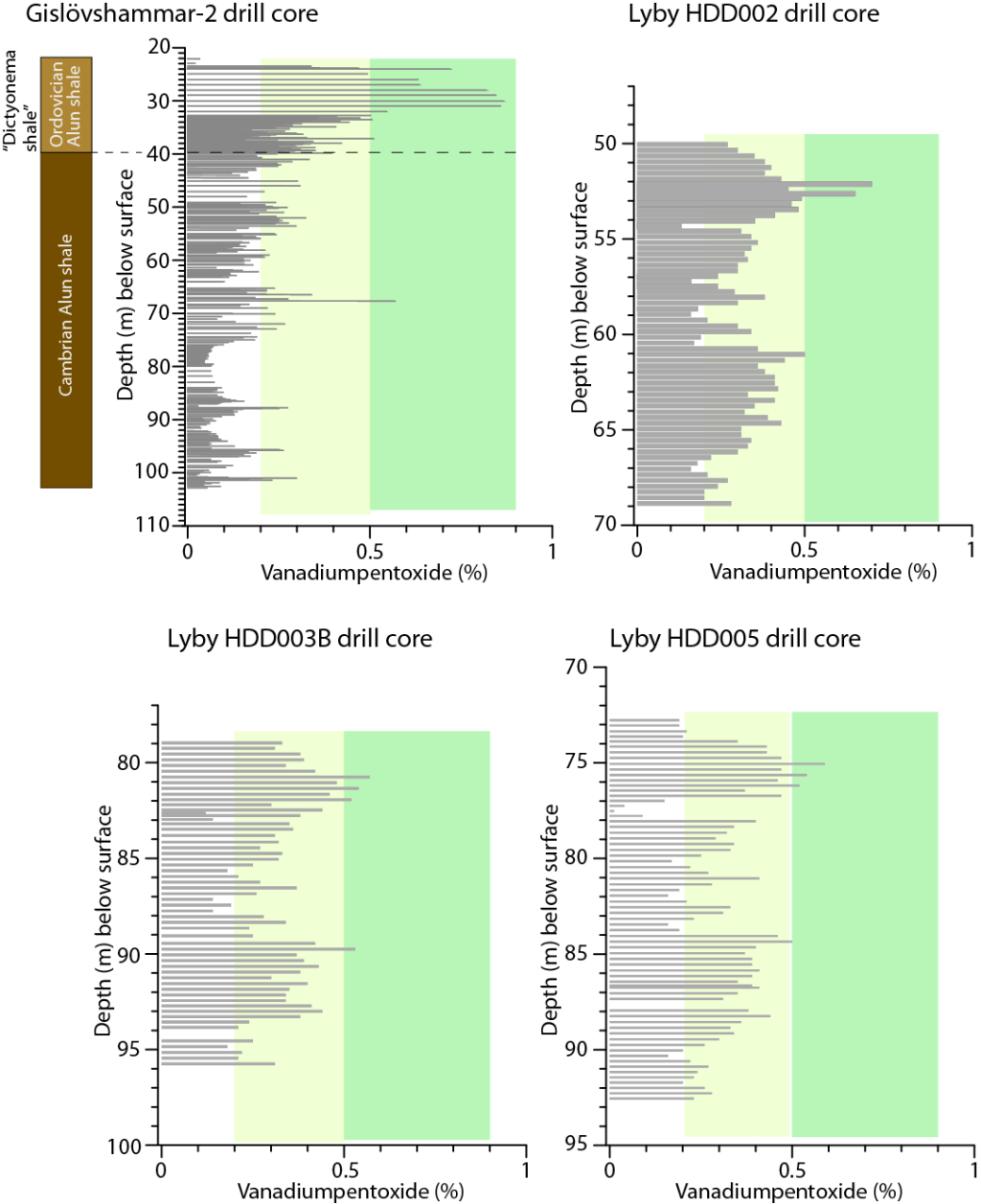ScandiVanadium concluded, based on their Lybymosse drill cores, that the “Dictyonema Formation” had been reached. First I thought that they are probably not correct. But when they reported their first results, I thought that they are indeed correct and that what they got actually does correspond to the lower Ordovician Alum shale (or what the company calls Dictyonema shale). I based this conclusion on the observation that in a normal stratigraphic succession older rocks are below younger rocks. But the thought that something is not as it should be, did not leave me. So I had another but different go at the available geological data sets.
We know from the geological literature and from previous drill cores that the lower Ordovician part of the Alum shale (which is called Tremadocian) is marked by especially high vanadium values of between 2500 and almost 5000 parts per million (ppm). It had been speculated in the older literature that these high vanadium values could be used to correlate the “Dictyonema shale” over larger distances. So I thought why not compare the vanadium values in the Lyby drill cores with those of the Gislövshammar-2 drill core, for which different data sets are available (Schovsbo 2001). Fossils that were analyzed in the Gislövshammar-2 drill core, alongside with geochemical variables, clearly show that the very high vanadium values relate to a specific zone in the upper part of the Alum shale. This zone is attributed to the lower Ordovician and corresponds to what is named Dictyonema shale by ScandiVanadium.
So I asked myself: are the reported vanadium values for Lybymosse actually in the same range as those that have been published for the Gislövshammar-2 drill core? If so, then it would be easy to correlate between the two sites and once for all conclude that ScandiVanadium‘s Dictyonema shale is present in the Lyby drill cores.
To solve the problem I looked again at ScandiVanadium‘s Lyby mosse data set, which is detailed in their latest ASX Announcement and made my own figures using the reported values. I also used the published Gislövshammar-2 drill core data set (Schovsbo 2001) for comparisons.
What did I find?
Let’s first look again at what ScandiVanadium reported and what is shown in the figure below: three drill cores (HDD002, HDD003B, HDD005) in which the rocks from top to bottom are shown as: grey color – Didymograptus (which refers to a middle Ordovician shale), blue color – middle Ordovician Komstad limestone and purple color – Dictyonema Formation (= lower Ordovician Alum shale). Reported percentages for vanadium pentoxide are shown by the green, yellow and red bars.

To make the comparisons, I converted the reported vanadium values (ppm) from the Gislövshammar-2 data set to vanadium pentoxide percentages and copied ScandiVanadium‘s reported vanadium pentoxide values into a spreadsheet. Then I was ready to make a few figures for comparing the data sets.
The part of the Gislövshammar drill core shown in the figure below comprises from top to bottom the Ordovician Alum shale (= Dictyonema) and the Cambrian Alum shale. The boundary between the two is at around 39.5 m depth. The Ordovician Alum shale has increasing vanadium pentoxide values and shows highest values of between 0.5 and 0.9% in the uppermost part. It is this part with significantly high vanadium values that has drawn the attention of ScandiVanadium. Values remain continuously high in the upper part of the Gislövshammar drill core and only decrease again in the very top.

But what do the Lyby cores show? Only two samples in HDD002, only three samples in HDD003B and only three samples in HDD005 reach above 0.5% vanadium pentoxide. Although samples were taken continuously along the Lyby drill cores, meaning that intervals with especially high vanadium pentoxide levels should have been able to detect, none of the samples reaches the values that are typical for the Dictyonema shale/lower Ordovician Alum shale (which are 0.5-0.9% vanadium pentoxide). As can be seen in the figure above, vanadium pentoxide percentages in the Lyby cores mainly range between 0.2 and 0.5%. Such values are very similar to those in the upper part of the Cambrian Alum shale and in the lowermost part of the Ordovician Alum shale in the Gislövshammar drill core.
Which part of the Alum shale is then actually present in the Lyby cores? Is it the lowermost part of the Ordovician Alum shale or is it the upper Cambrian Alum shale? These questions are difficult to answer given the available data sets. To answer these questions, we would need a detailed description of the rocks and an analysis of the tiny fossils in the Lyby cores to being able to exactly correlate to the Gislövshammar core.
But what is sure is that the Lyby cores did not reach the target – the interval with vanadium pentoxide percentages of 0.5-0.9%.
Also, independent from the question which part of the Alum shale is actually present in the Lyby drill cores, it is obvious that the intervals with slightly elevated vanadium pentoxide levels are at depths of 50 to 95 m, which is pretty deep for an open mine. It is also obvious that mining of an Alum shale with such low vanadium pentoxide values would mean that enormous amounts of shale will need to be processed and the remains deposited somewhere. All in all a very doubtful project.
Reference:
Schovsbo, N.H. 2001: Why barren intervals? A taphonomic case study of the
Scandinavian Alum Shale and its faunas. Lethaia, Vol. 34, pp. 271–285. Oslo. ISSN
0024-1164.

